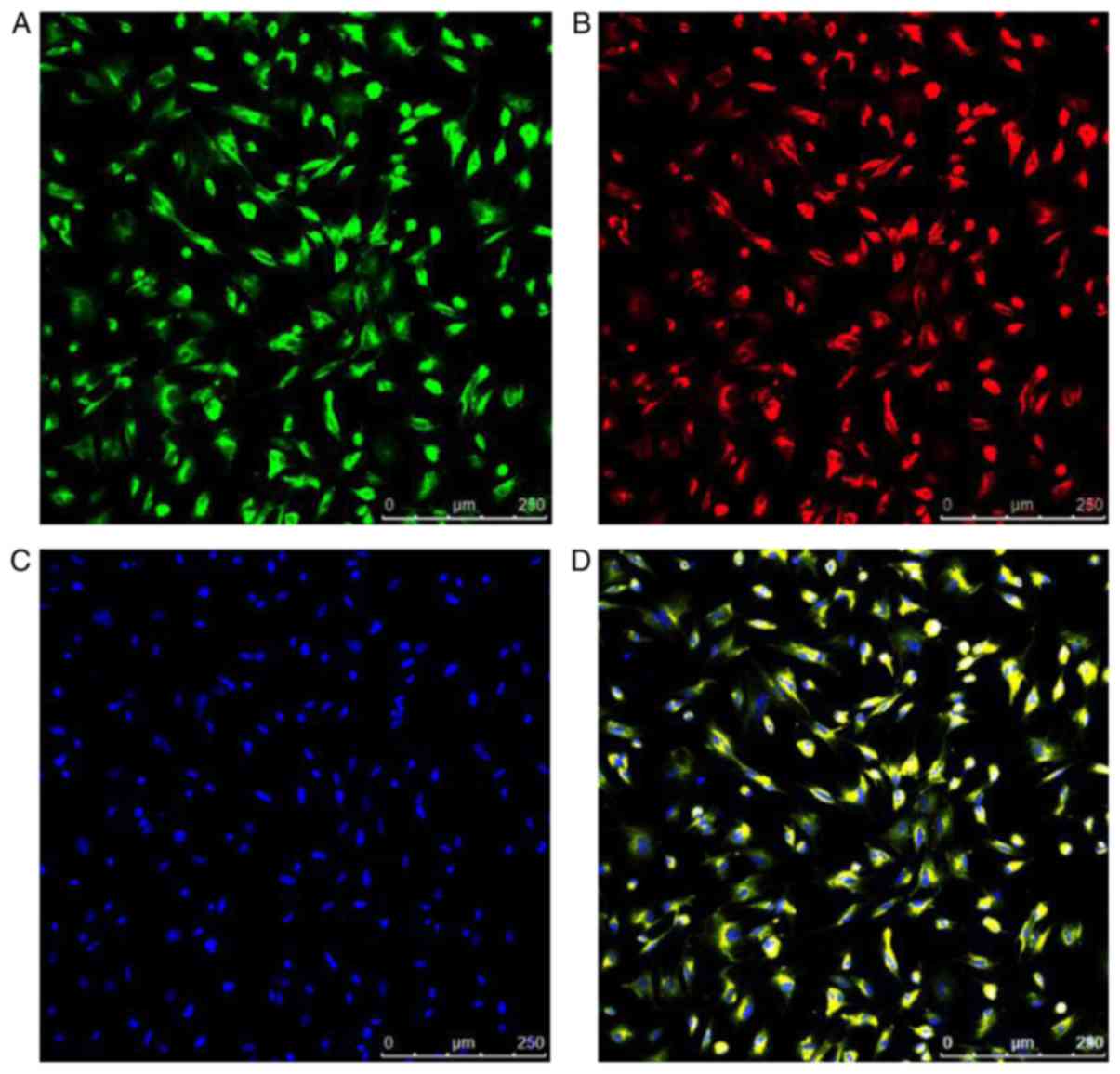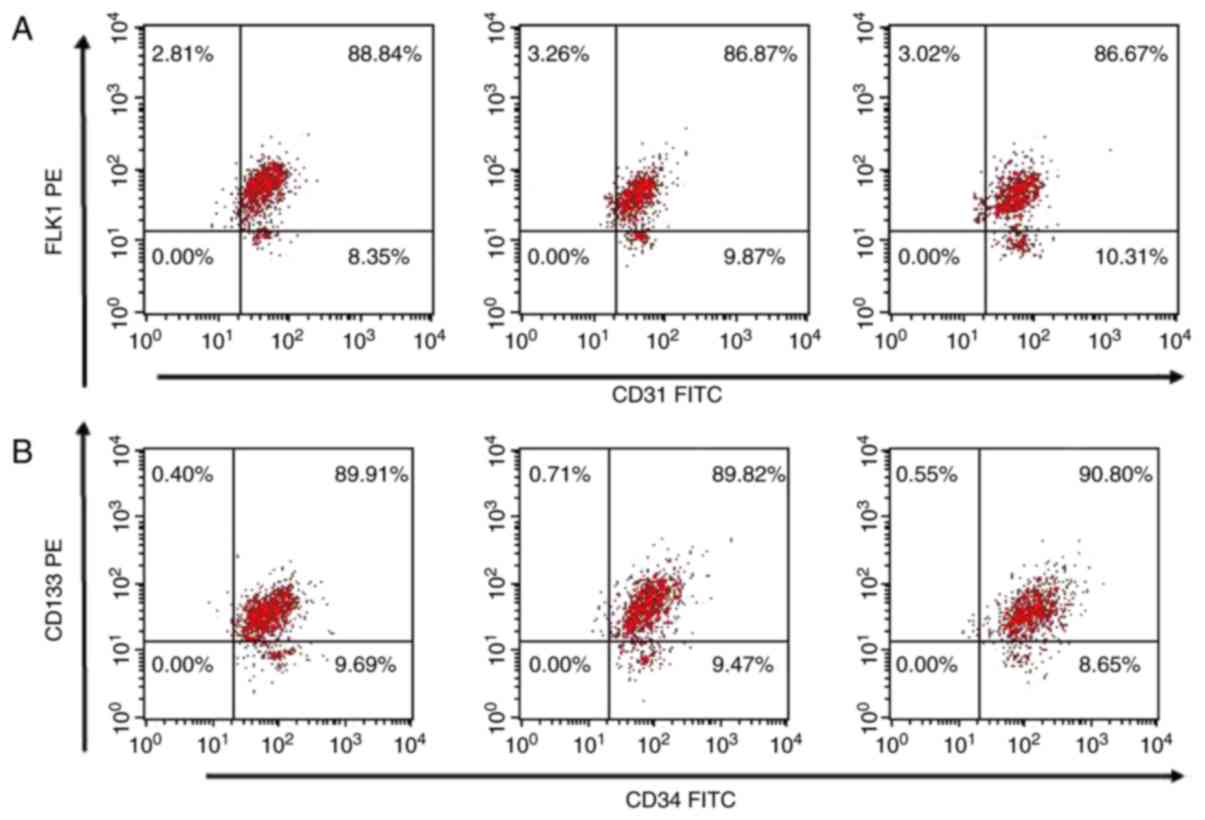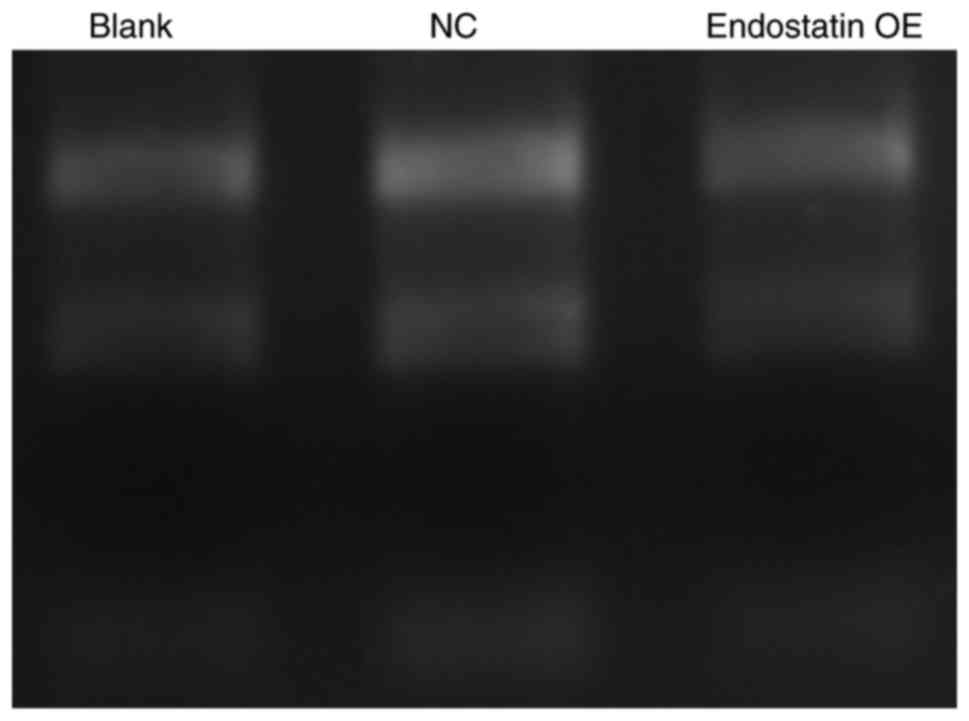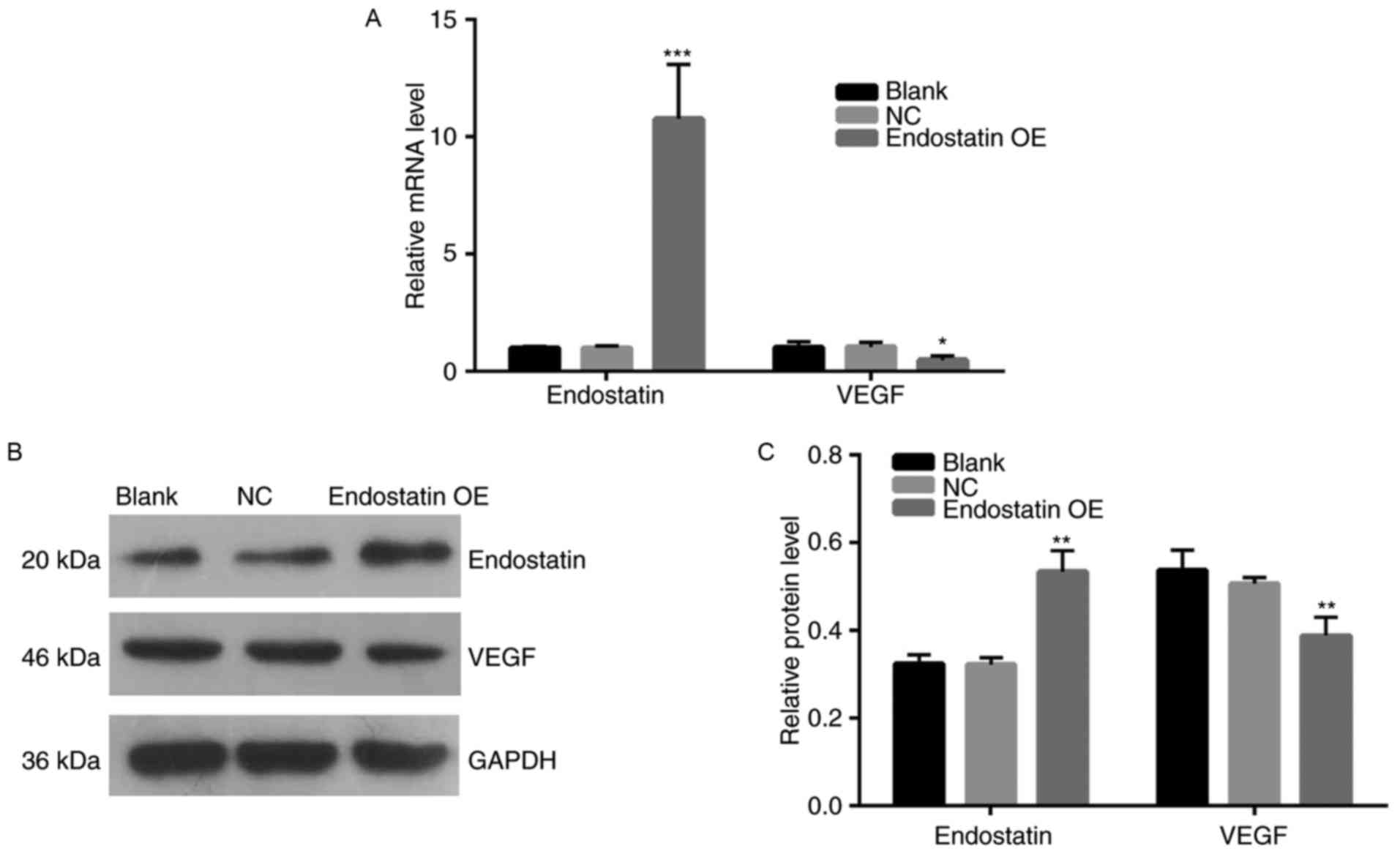|
1
|
Zhang SX and Ma JX: Ocular
neovascularization: Implication of endogenous angiogenic inhibitors
and potentialtherapy. Prog Retin Eye Res. 26:1–37. 2007. View Article : Google Scholar : PubMed/NCBI
|
|
2
|
Kong D, Melo LG, Gnecchi M, Zhang L,
Mostoslavsky G, Pratt RE and Dzau VJ: Cytokine-induced mobilization
of circulating endothelial progenitor cells enhances repair of
injured arteries. Circulation. 110:2039–2046. 2004. View Article : Google Scholar : PubMed/NCBI
|
|
3
|
Hu Y, Davison F, Zhang Z and Xu Q:
Endothelial replacement and angiogenesis in arteriosclerotic
lesions of allografts are contributed by circulating progenitor
cells. Circulation. 108:3122–3127. 2003. View Article : Google Scholar : PubMed/NCBI
|
|
4
|
Abe Y, Ozaki Y, Kasuya J, Yamamoto K, Ando
J, Sudo R, Ikeda M and Tanishita K: Endothelial progenitor cells
promote directional three-dimensional endothelial network formation
by secreting vascular endothelial growth factor. PLoS One.
8:e820852013. View Article : Google Scholar : PubMed/NCBI
|
|
5
|
O'Reilly MS, Boehm T, Shing Y, Fukai N,
Vasios G, Lane WS, Flynn E, Birkhead JR, Olsen BR and Folkman J:
Endostatin: An endogenous inhibitor of angiogenesis and tumor
growth. Cell. 88:277–285. 1997. View Article : Google Scholar : PubMed/NCBI
|
|
6
|
Dudek AZ, Bodempudi V, Welsh BW, Jasinski
P, Griffin RJ, Milbauer L and Hebbel RP: Systemic inhibition of
tumour angiogenesis by endothelial cell-based gene therapy. Br J
Cancer. 97:513–522. 2007. View Article : Google Scholar : PubMed/NCBI
|
|
7
|
Dhanabal M, Ramchandran R, Volk R,
Stillman IE, Lombardo M, Iruela-Arispe ML, Simons M and Sukhatme
VP: Endostatin: Yeast production, mutants, and antitumor effect in
renal cell carcinoma. Cancer Res. 59:189–197. 1999.PubMed/NCBI
|
|
8
|
Mori K, Duh E, Gehlbach P, Ando A,
Takahashi K, Pearlman J, Mori K, Yang HS, Zack DJ, Ettyreddy D, et
al: Pigment epithelium-derived factor inhibits retinal and
choroidal neovascularization. J Cell Physiol. 188:253–263. 2001.
View Article : Google Scholar : PubMed/NCBI
|
|
9
|
Sun JH, Zhang YL, Nie CH, Qian SP, Yu XB,
Xie HY, Zhou L and Zheng SS: In vitro labeling of endothelial
progenitor cells isolated from peripheral blood with
superparamagnetic ironoxide nanoparticles. Mol Med Rep. 6:282–286.
2012. View Article : Google Scholar : PubMed/NCBI
|
|
10
|
Hristov M, Erl W and Weber PC: Endothelial
progenitor cells: Isolation and characterization. Trends Cardiovasc
Med. 13:201–206. 2003. View Article : Google Scholar : PubMed/NCBI
|
|
11
|
Sun W, Zheng L, Han P and Kang YJ:
Isolation and characterization of endothelial progenitor cells from
Rhesus monkeys. Regen Med Res. 2:52014. View Article : Google Scholar : PubMed/NCBI
|
|
12
|
Dome B, Dobos J, Tovari J, Paku S, Kovacs
G, Ostoros G and Timar J: Circulating bone marrow-derived
endothelial progenitor cells: characterization, mobilization and
therapeutic considerations in malignant disease. Cytometry A.
73:186–193. 2008. View Article : Google Scholar : PubMed/NCBI
|
|
13
|
Rafii S, Lyden D, Benezra R, Hattori K and
Heissig B: Vascular and haematopoietic stem cells: Novel targets
for anti-angiogenesis therapy? Nat Rev Cancer. 2:826–835. 2002.
View Article : Google Scholar : PubMed/NCBI
|
|
14
|
Asahara T, Murohara T, Sullivan A, Silver
M, van der Zee R, Li T, Witzenbichler B, Schatteman G and Isner JM:
Isolation of putative progenitor endothelial cells for
angiogenesis. Science. 275:964–967. 1997. View Article : Google Scholar : PubMed/NCBI
|
|
15
|
Livak KJ and Schmittgen TD: Analysis of
relative gene expression data using real-time quantitative PCR and
the 2(-Delta Delta C(T)) method. Methods. 25:402–408. 2001.
View Article : Google Scholar : PubMed/NCBI
|
|
16
|
Friedrich EB, Walenta K, Scharlau J,
Nickenig G and Werner N: CD34/CD133+/VEGFR-2+
endothelial progenitor cell subpopulation with potent
vasoregenerative capacities. Circ Res. 98:e20–e25. 2006. View Article : Google Scholar : PubMed/NCBI
|
|
17
|
Paczkowska E, Gołąb-Janowska M,
Bajer-Czajkowska A, Machalińska A, Ustianowski P, Rybicka M, Kłos
P, Dziedziejko V, Safranow K, Nowacki P, et al: Increased
circulating endothelial progenitor cells in patients with
haemorrhagic and ischaemic stroke: The role of endothelin-1. J
Neurol Sci. 325:90–99. 2013. View Article : Google Scholar : PubMed/NCBI
|
|
18
|
Grant MB, May WS, Caballero S, Brown GA,
Guthrie SM, Mames RN, Byrne BJ, Vaught T, Spoerri PE, Peck AB, et
al: Adult hematopoietic stem cells provide functional hemangioblast
activity during retinal neovascularization. Nat Med. 8:607–612.
2002. View Article : Google Scholar : PubMed/NCBI
|
|
19
|
Tomita M, Yamada H, Adachi Y, Cui Y,
Yamada E, Higuchi A, Minamino K, Suzuki Y, Matsumura M and Ikehara
S: Choroidal neovascularization is provided by bone marrow cells.
Stem Cells. 22:21–26. 2004. View Article : Google Scholar : PubMed/NCBI
|
|
20
|
Tsai SH, Huang PH, Chang WC, Tsai HY, Lin
CP, Leu HB, Wu TC, Chen JW and Lin SJ: Zoledronate inhibits
ischemia-induced neovascularization by impairing the mobilization
and function of endothelial progenitor cells. PLoS One.
7:e410652012. View Article : Google Scholar : PubMed/NCBI
|
|
21
|
Butler JM, Guthrie SM, Koc M, Afzal A,
Caballero S, Brooks HL, Mames RN, Segal MS, Grant MB and Scott EW:
SDF-1 is both necessary and sufficient to promote proliferative
retinopathy. J Clin Invest. 115:86–93. 2005. View Article : Google Scholar : PubMed/NCBI
|
|
22
|
Losordo DW and Dimmeler S: Therapeutic
angiogenesis and vasculogenesis for ischemic disease: Part II:
Cell-based therapies. Circulation. 109:2692–2697. 2004. View Article : Google Scholar : PubMed/NCBI
|
|
23
|
Caballero S, Sengupta N, Afzal A, Chang
KH, Li Calzi S, Guberski DL, Kern TS and Grant MB: Ischemic
vascular damage can be repaired by healthy, but not diabetic,
endothelial progenitor cells. Diabetes. 56:960–967. 2007.
View Article : Google Scholar : PubMed/NCBI
|
|
24
|
Liew A, Barry F and O'Brien T: Endothelial
progenitor cells: Diagnostic and therapeutic considerations.
Bioessays. 28:261–270. 2006. View Article : Google Scholar : PubMed/NCBI
|
|
25
|
Bai YJ, Huang LZ, Zhou AY, Zhao M, Yu WZ
and Li XX: Antiangiogenesis effects of endostatin in retinal
neovascularization. J Ocul Pharmacol Ther. 29:619–626. 2013.
View Article : Google Scholar : PubMed/NCBI
|
|
26
|
Chen R, Yu H, An YL, Chen HJ, Jia Z and
Teng GJ: Endothelial progenitor cells combined with cytosine
deaminase-endostatin for suppression of liver carcinoma. J Biomed
Nanotechnol. 12:1174–1182. 2016. View Article : Google Scholar : PubMed/NCBI
|
|
27
|
Baharivand N, Zarghami N, Panahi F, Dokht
Ghafari MY, Mahdavi Fard A and Mohajeri A: Relationship between
vitreous and serum vascular endothelial growth factor levels,
control of diabetes and microalbuminuria in proliferative diabetic
retinopathy. Clin Ophthalmol. 6:185–191. 2012.PubMed/NCBI
|
|
28
|
Szary J and Szala S: Intra-tumoral
administration of naked plasmid DNA encoding mouse endostatin
inhibits renal carcinoma growth. Int J Cancer. 91:835–839. 2001.
View Article : Google Scholar : PubMed/NCBI
|
|
29
|
Otani A, Kinder K, Ewalt K, Otero FJ,
Schimmel P and Friedlander M: Bone marrow-derived stem cells target
retinal astrocytes and can promote or inhibit retinal angiogenesis.
Nat Med. 8:1004–1010. 2002. View
Article : Google Scholar : PubMed/NCBI
|
|
30
|
Hansen TM, Moss AJ and Brindle NP:
Vascular endothelial growth factor and angiopoietins in
neurovascular regeneration and protection following stroke. Curr
Neurovasc Res. 5:236–245. 2008. View Article : Google Scholar : PubMed/NCBI
|
|
31
|
Hirashima M, Kataoka H and Nishikawa S,
Matsuyoshi N and Nishikawa S: Maturation of embryonic stem cells
into endothelial cells in an in vitro model of vasculogenesis.
Blood. 93:1253–1263. 1999.PubMed/NCBI
|
|
32
|
Eichmann A, Corbel C, Nataf V, Vaigot P,
Bréant C and Le Douarin NM: Ligand-dependent development of the
endothelial and hemopoietic lineages from embryonic mesodermal
cells expressing vascular endothelial growth factor receptor 2.
Proc Natl Acad Sci USA. 94:pp. 5141–5146. 1997; View Article : Google Scholar : PubMed/NCBI
|
|
33
|
Dimmeler S, Dernbach E and Zeiher AM:
Phosphorylation of the endothelial nitric oxide synthase at
ser-1177 is required for VEGF-induced endothelial cell migration.
FEBS Lett. 477:258–262. 2000. View Article : Google Scholar : PubMed/NCBI
|
|
34
|
Connolly DT, Heuvelman DM, Nelson R,
Olander JV, Eppley BL, Delfino JJ, Siegel NR, Leimgruber RM and
Feder J: Tumor vascular permeability factor stimulates endothelial
cell growth and angiogenesis. J Clin Invest. 84:1470–1478. 1989.
View Article : Google Scholar : PubMed/NCBI
|
|
35
|
Dieudonné SC, La Heij EC, Diederen RM,
Kessels AG, Liem AT, Kijlstra A and Hendrikse F: Balance of
vascular endothelial growth factor and pigment epithelial growth
factor prior to development of proliferative vitreoretinopathy.
Ophthalmic Res. 39:148–154. 2007. View Article : Google Scholar : PubMed/NCBI
|
|
36
|
Funatsu H, Noma H, Mimura T, Eguchi S and
Hori S: Association of vitreous inflammatory factors with diabetic
macular edema. Ophthalmology. 116:73–79. 2009. View Article : Google Scholar : PubMed/NCBI
|














